Crawler excavators: Right on track
08 October 2019
Crawler excavators may not be the fastest machines around a jobsite, but they’re among the most reliable and are no slouches when it comes to technology. Joe Sargent reports
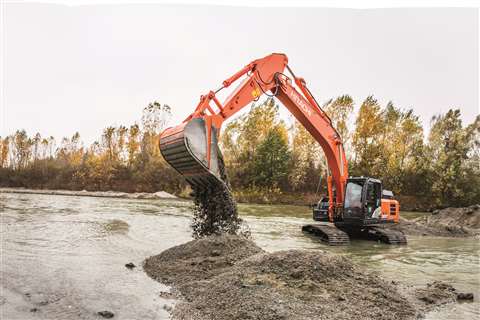
The excavator is the number one piece of construction equipment sold worldwide. More than 450,000 units were sold globally in 2018 – with a complete sales figure of over 400,000 units anticipated by the end of this year, according to statistics from specialist data company, Off-Highway Research.
The machine literally shapes the landscape on which the construction industry builds. Frequently these machines must trawl through muddy sites and sometimes even small rivers to ply their trade. There is no machine that is more adept or adapted to suit the task than a crawler excavator.
An example of what crawlers are capable of is demonstrated by one of Hitachi’s ZX300LC-6 medium sized excavators. Under the command of NBG, a Romanian aggregate supplier, the machine has been used to dredge materials from the Arges River for use in concrete production, at a busy 1.5km2 site that is approximately 30km west of the capital, Bucharest.
A wheeled excavator could easily get bogged down navigating the river, but it proves no challenge for a crawler. NBG’s machinery manager, Razvan Vişan, said, “We selected the ZX300LC-6 because we needed a strong machine with a high ground clearance. It also had to be capable of increasing productivity.”
However, these excavators aren’t just delivering machine power in tough locations; they are now also helping to maximise power. Vişan was supportive of Hitachi’s data report service, ConSite, saying that it was a great help for monitoring fuel consumption.
In the industry today, domestic contractors don’t just need to compete internally; they are tendering for many jobs against multinationals and this can leave a firm’s profits looking a little thin. It’s all about the bottom line; if you can maximise efficiency, then you’re on the right track.
Hitachi says that its ConSite software can help minimise machinery downtime. If a fault occurs, the software will send the fleet manager and the purchaser’s authorised Hitachi dealer an emergency alarm report in order to increase response time.
The software also constantly monitors the oil. For example, if oil quality deteriorates or the oil becomes contaminated, a local dealer will be notified so the cause can quickly be identified.
Valuable machines
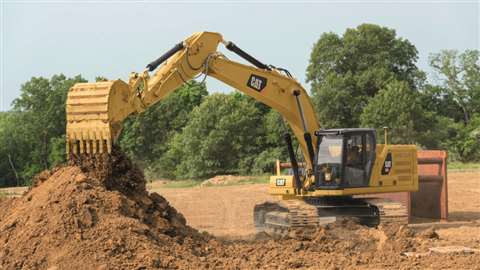
This sort of software is becoming something of a trend in the excavator segment as machines are now expected to deliver not just more power but better utilisation of their capabilities. Caterpillar’s Cat Connect software is now offered as standard on the company’s current generation of 30 tonne crawlers.
The 330 and 330 GC have been available commercially for over a year now and have proven to be valuable machines for improving fuel and operating efficiency.
Cat Connect is an equipment management system that tracks the location of the machine, how efficiently it is being operated, how much fuel is being burned off each hour and rapid information processing on machine diagnostics to help maintain the machine and improve uptime.
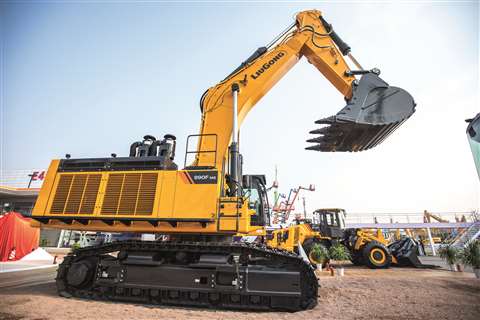
Also offering advanced excavator technology is LiuGong, which recently unveiled its latest F Series excavator line-up. These machines, unveiled at the 2019 Bices show in Beijing, China, come equipped with improved intelligence systems, which, LiuGong says, will combine the integrated operation of a single excavator with a whole network-based integration of machines, intelligent monitoring, detection, prediction and remote control.
Though the excavators are not yet available in Europe, the machines will also adopt new electronic fence technology that ensures safer construction, and will monitor bucket trajectories to assist the operator.
A machine that has been very much designed for the European market is Doosan’s latest medium sized crawler excavator – the DX300LC-7 – in the 30 tonne class. The Korean firm has developed the machine to be the company’s first Stage V machine in the medium-sized category.
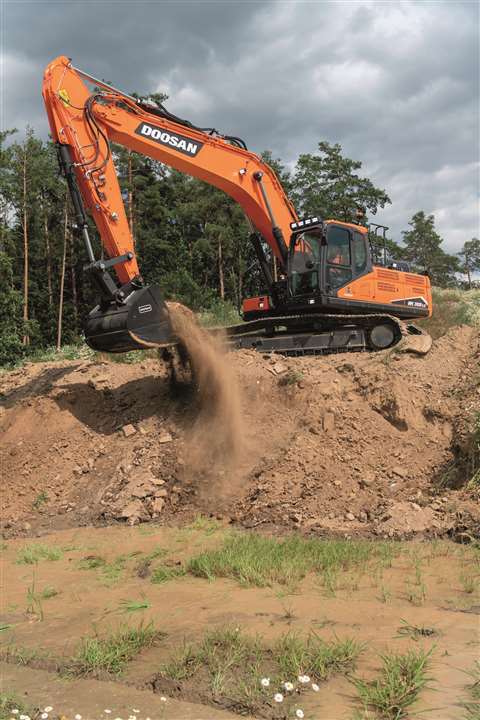
As standard, the new excavator comes with four cameras around the machine, providing the operator with a 360° external view. Also factory installed is DoosanConnect – Doosan’s answer to the wireless fleet monitoring software that so many original equipment manufacturers (OEMs) are beginning to provide.
Stephane Dieu, Doosan Heavy Excavator product manager, discussed the equipment on board the DX300LC-7. According to Dieu, the machine requires good quality fuel with low Sulphur levels (the same fuel that is used in cars). In the previous generation machines using a diesel particulate filter (DPF), the DPF needed replacing after 4,000 hours. On the new machines, maintenance intervals are as long as 8,000 hours.
On Doosan’s monitoring software, Dieu said, “The DoosanConnect system allows owners to follow their machines, at any time, from anywhere – could be from the office or from a mobile application.
“You can monitor many aspects, including efficiency, fuel consumption, operating hours, working modes and any maintenance that needs to be carried out. It also allows you to know exactly where your machine is located, and to set up alerts if the machine goes out of geo limitation zones that you can define.”
European regulations
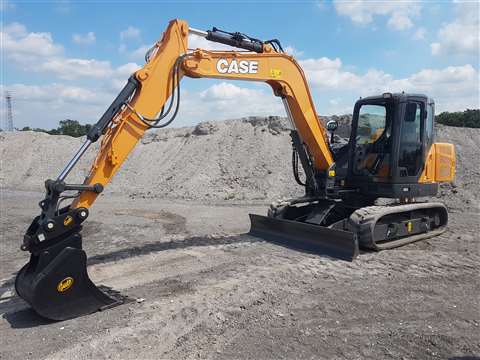
Another company making strides into the Euro Stage V marketplace is Italian manufacturer Case Construction Equipment. The OEM recently announced the first European sale of its latest Stage V excavator.
The machine, a CASE CX90D, was sold to UK engineering and administration service providers Civil & Construction Solutions, to be used in the road and sewer side of the company’s offering.
Sandro Vitale, product director for general construction at Case Construction Equipment Europe, said, “The Yanmar Stage V engine used in the CX90D is the most powerful in the segment. As well as meeting the legislation requirements, we also deliver 20% more power with a 4.5% decrease in fuel usage.”
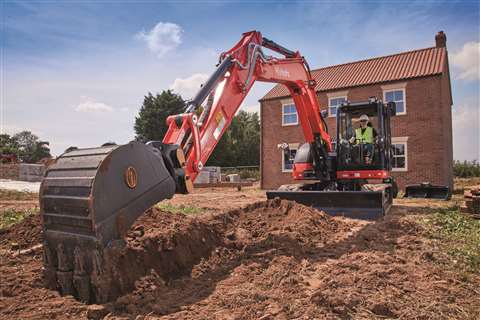
Japan-headquartered firm Kubota recently unveiled its latest offering in the crawler excavator market – the new KX080-4a2 midi excavator. The new machine is capable of the same performance output as previous models but includes Kubota’s V3307 direct injection engine - which is now fully Stage-V compliant.
As well as its reduced potential impact on the environment, the maintenance intervals have also been increased. The new model has a reduced RPM requirement to run its DPF regeneration and an increased filter life, which reduces maintenance intervals and lowers noise levels.
The KX080-4a2 incorporates a new two-pump load-sensing hydraulic system, which, Kubota says, ensures smoother operations when using front attachments, regardless of loading size. By allowing hydraulic oil to flow according to the specific range of the operator’s lever motion, the new system reduces fuel consumption and improves the overall operating performance. The machine’s auto idling system is fitted as standard.
The excavator can also be equipped with a two-piece boom. In this configuration, Kubota says operation remains simple while its hydraulic mechanism enables smooth control. Users can also benefit from greater working range, and improved ability to operate in narrow spaces.
Technological boom
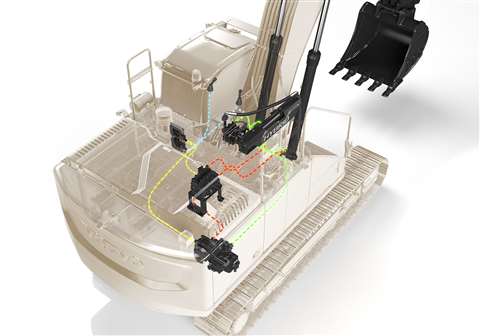
Another company working specifically on the technology used in the boom and arm of its crawler excavators is Volvo Construction Equipment (Volvo CE).
While not commercially available yet, the Swedish company is developing EC300E Hybrid crawler excavators, which are currently undergoing field tests at customer sites.
The excavator will have a new energy saving feature when initiating a boom-down motion. During this action, the machine charges energy-storing accumulators that are used to power the hydraulic pump.
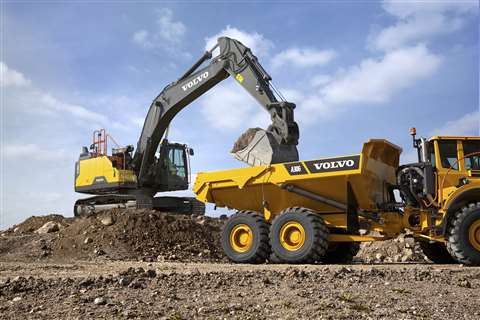
Unlike other systems that capture the swing energy of an excavator’s superstructure to electrically assist the engine, Volvo’s hydraulic hybrid harvests ‘free’ energy generated by the down motion of the excavator’s boom, charging the hydraulic system.
The 20-litre hydraulic accumulators then deliver energy to drive hydraulic assist motors that help power the hydraulic pump. Volvo CE says the machine still provides the same levels of controllability and performance as the standard EC300E, including the ability to work in ECO mode and Hybrid mode simultaneously.
The new system takes load off the engine and in the process delivers between 10-12% lower fuel consumption and produces up to 12% less CO2 emissions – without loss of performance. The company says with the benefits of this machine it can pay for itself in just over a year.
Of course, not all excavators these days have diesel on board. Volvo CE may be championing the electric market for construction equipment as Melker Jernberg, Volvo CE President, said the company was looking to create the market, but three other companies that have also developed electric excavators immediately spring to mind; US-based Bobcat, UK-based JCB and German OEM Wacker Neuson.
Each has thrown its hat into the ring to provide a machine capable of delivering zero emissions in the crawler excavator sector.
When working in confined spaces, engine fumes are a problem. It makes sense that companies would capitalise on the potential applications for using a zero-emissions machine indoors.
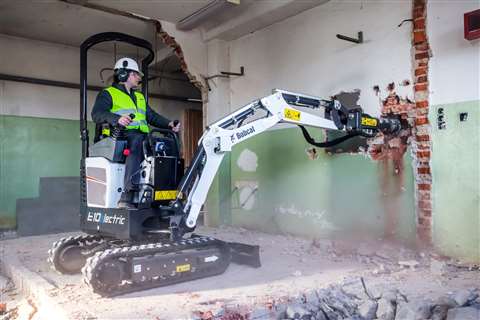
Bobcat has produced the world’s first 1 tonne electric mini excavator. At 71cm wide, the model can pass through a single doorway. The concept has proven a hit with contractors and the company can no longer fulfil anymore orders for the year. Production of the company’s first E10e zero tail swing (ZTS) electric mini-excavator for 2019 was sold out in July.
The tracked models are produced at the Bobcat’s Dobris factory in the Czech Republic, which has a production capacity of 2,000 units per year.
Jarry Fiser, mini-excavator product line director at Doosan Bobcat EMEA, said, “We are very pleased that actual demand is higher than our original expectations and production capacities.
“The E10e is just the start of our journey in further expanding our portfolio in alternative power sources. The 2019 production capacity is already sold out and we are accepting orders for delivery in 2020.”
Powerful performance
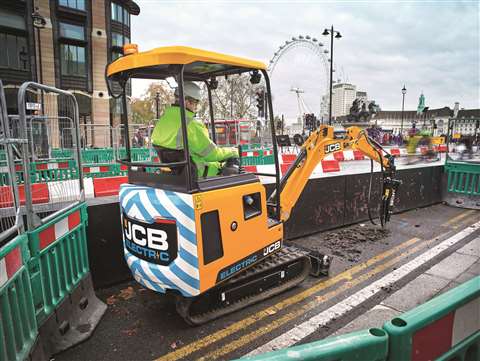
JCB is also producing its own electric excavator which it claims to be the first ever to be commercially produced.
The company says the machine has been designed for both outdoor and indoor applications and that it’s five times quieter than an equivalent diesel-powered machine. In fact, JCB assures that the 19C-1E will deliver the performance of a conventional diesel-powered 1.9-tonne mini excavator with a reduction of both internal and external noise levels.
Wacker Neuson is equally confident that its electric offering, the EZ17e, handles just like a conventional excavator in the same weight class.
The German OEM claims that no other manufacturer offers as broad a portfolio of electrically-powered equipment. The company’s zero emissions line-up stretches further than excavators and currently comprises three battery-powered rammers, a dual power excavator, one electric wheeled loader, an electric tracked and an electric wheeled dumper as well as three battery-powered vibratory plates.
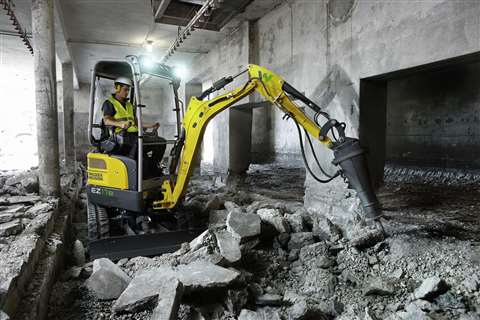
Expected to be commercially available next year, the EZ17e is powered by lithium-ion batteries, which, Wacker Neuson says, enable the fully electric excavator to be operated over a full working shift. The battery can be charged overnight via a domestic socket (110-230 V), or in just four hours using a high-voltage current.
Alexander Greschner, CSO of the Wacker Neuson Group, said, “Electric drives are becoming increasingly important. For rental companies in particular, these solutions are an interesting supplement to existing fleets as many of their customers rent products for specific projects such as renovation work inside buildings or tunnel construction.”
Product specialist Alex MacDonald discusses Cat’s mini-excavators
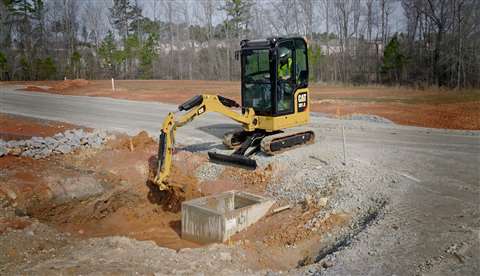
Other than fuel efficiency and longer service intervals, what other considerations were taken into account when designing the machines?
“The next generation of Cat mini excavators was developed after extensive research with customers across the world. We listened to what they told us and set to offer the best owning and operating costs, provide even more performance and an even better experience for the operator.
“We worked to increase parts commonality across machines of similar sizes and build them from the same base platform to allow for cost reductions that could be passed to customers. We also looked at other elements, such as repair parts and, as an example, the access doors are now flush with the machine body. Key repair parts can also be more easily replaced. Service intervals have been extended.
“To increase performance, we designed a new smart hydraulic system from the ground-up which enables operators to efficiently use multiple machine functions simultaneously, such as tracking and handling material, or with an attachment such as a mulcher.
“One of the “industry first” features we introduced is adjustable operator settings that allows the operator to work with a machine that is precisely set to their own parameters.”
The excavator is increasingly becoming a multi-tool carrier for lifting, digging, grading, even loading applications. Is there a specific focus that Caterpillar works to achieve when designing these machines?
“When we develop a machine, we look at the total cost of ownership during its lifetime: acquisition, operations, maintenance and divestment. By focusing on costs we can influence such as maintenance and repair and tuning the machines to be more efficient than ever, we believe these next generation mini excavators benefit from some of the lowest total costs of ownership in the industry.
“The applications mini excavators work in is evolving and those machines are used for a lot more than the traditional digging. Our new model, the Cat 309 CR with high-flow auxiliaries has been designed for multi-function applications that operate hydro-mechanical tools.”
What are the key market areas for these models within Europe?
“The UK, Germany and France are large markets. We are seeing a healthy demand across the region. In addition, applications such as land management and waste handling are growing.”
Off-Highway Research insight
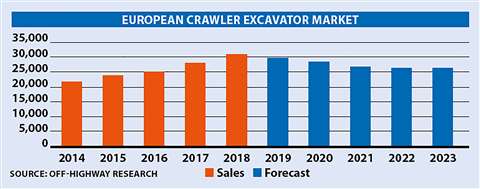
Sales of crawler excavators above six tonnes exceeded 30,000 machines last year for the first time in a decade, according to specialist market research and forecasting company, Off-Highway Research. In fact it has taken the market ten years of steady and continuous growth to reach that level, having bottomed-out at deep low of 13,700 units in 2009, following the global financial crisis. Off-Highway Research puts the current value of the European excavator market at more than US$4 billion per year (€3.65 billion).
By far the largest market in Europe is the UK, where sales were more than 9,500 machines last year. This is significantly more than both France and Germany, where wheeled machines occupy a big slice of demand from 6-25 tonnes or so, displacing tracked units.
Other major markets in Europe include Italy, while Norway is surprisingly large given its small population, with almost 1,900 crawler excavators sold last year.
Off-Highway Research believes 2018 will represent the peak in the current market cycle in Europe, although sales are expected to stay at a comparable level both this year and next. Even when the decline becomes more pronounced from 2021 onwards, volumes should stay reasonable at around 26,000 machines per year.
Kobelco’s K-Dive
That there is a global shortage of skilled construction workers is no longer in doubt; the question now is whether this is a full-blown crisis or an issue which can be worked around successfully, for example through the usage of new technology.
Kobelco has been working on a concept project that will allow the remote control of machines from anywhere in the world. The K-Dive initiative, currently in the testing phase, would see fifth generation (5G) network connectivity facilitate the operation of site machinery while operators sit in an office-like environment.
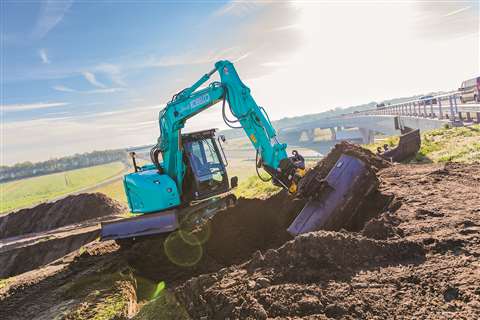
If this becomes a reality in the future, operators may not need to sit idle on jobsites when there is no work and could potentially switch between operating machines all around the world.
While still just a concept, in theory, this kind of remote working could also give construction companies access to dangerous jobsites such as industrial waste disposal sites, disaster zones, and regions of extremely cold temperature.
The software also has potential applications in which operators who are unable to physically work on a jobsite due to geographical or time restrictions could still move projects forward.




